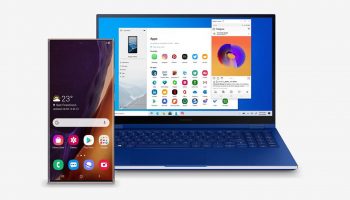
For the past few weeks, I have been using the Samsung Galaxy Note20 Ultra 5G as my go-to phone. The Galaxy Note20 Ultra 5G is Samsung’s newest offering aimed at Android users that view smartphones as an ultimate productivity platform.
Forbes.com – August 24, 2020
The Note20 Ultra is the follow on to the Note10 Plus and makes some significant improvements, especially in terms of cameras and display. It worth noting that my device was attached to T-Mobile’s 5G network.
The Galaxy Note line of devices has always been one that I have enjoyed using. The phones sport large, bright displays, a responsive stylus, sharp cameras, and some of the best specs available on a smartphone. The Note20 Ultra may be overkill for the average user. For those users looking to push a smartphone to its limit, look no further.
Build quality and first impressions
Out of the box, the Note20 Ultra feels sleek and premium. The massive 6.9″ display sticks out immediately and looks clear and crisp. The curved edges on the screen are smooth and taper off at just the right angle.My Note20 unit came in the new Mystic Bronze color scheme, and I liked the look of the color option, even if it looked a bit rose gold. The Note20 also comes in two more alternative color options, including Mystic White and Mystic Black. I appreciate that Samsung offered a few different color options, but I admit that color doesn’t mean as much to me as I always run a protective case on my smartphones.
The 6.9″ AMOLED 2X Infinity-O display on the Note20 Ultra is one of the best I have ever used in a smartphone. Independent display researcher and tester DisplayMate agrees. Like the Galaxy S20 Ultra, the Note20 Ultra also sports a super responsive 120 Hz display. Since the introduction in the S20 Ultra, I have fallen in love with 120Hz. The Note20 Ultras screen has a 3088 x 1440 resolution and 496 ppi. Every swipe and finger touch was accurate and responsive. It was easy to text, respond to emails, watch YouTube videos, or take notes on this device. Even though the display is huge, I was able to use it easily. The only time I found myself putting two hands on the phone for control was when I used the very top portion of the display. It was also easy to use the built-in fingerprint sensor to log in to the device and I prefer this over using an optical sensor.
I especially like the ability to pin applications on the display while using other apps. I use this function a lot while watching videos. I often pin the video at the top of the screen and then reply to a text message without having to exit the other application. The 120 Hz display helps a lot with latency while using the built-in S Pen. The S Pen was very accurate and responsive when I quickly jotted down notes or marked up a photo.
The bezel of the phone is minimalistic in terms of the number of buttons on the device. The Note20 Ultra has a power button, volume control button, microSD slot, S Pen slot, and a USB-C charging port. The USB-C charging port is certified for Fast Charging capabilities when plugged into a wired charger.
Specs of the Galaxy Note20:
- Qualcomm Snapdragon 865 Plus processor
- 12 GB of RAM
- 128GB of storage
- microSD slot that can support up to 1TB
- Android 10 OS
I was impressed with the Snapdragon 865 Plus processor’s performance. I didn’t feel any lag or latency while using the device and switching between and using different applications was a breeze. It was a snappy experience to use the 120 Hz display paired with the Snapdragon 865 Plus. My review unit came with 128GB of storage, but I can easily triple my storage capacity without upgrading devices by adding a 256GB microSD card for $40 from Amazon. That’s a valuable feature that you’re not going to get with an Apple iPhone.
Camera
We must address the sizeable protruding camera bump that is present on the Galaxy Note20 Ultra. It is noticeable and does cause the device not to lay completely flat. I said the same thing about the Galaxy S20 Ultra; this phone is one that begs for a case. When paired with a protective case, the protruding camera bump quickly becomes a distant memory.
As far as cameras go, the Galaxy Note 20 Ultra sits at the top of the smartphone cameras’ food chain. The camera options are a good upgrade from the Galaxy Note 10 and rival the iPhone 11 Pro Max. The full configs are below.
- Selfie Camera: 10 MP, Dual Pixel AF, and F2.2 aperture.
- First Back Camera: 12 MP Ultra-Wide Camera, 120-degree FOV, and F2.2 aperture
- Second Back Camera: 108 MP Wide-angle Camera, 79-degree FOV, and F1.8 aperture
- Third Back Camera: 12 MP Telephoto Camera, 20-degree FOV, and F3.0 aperture
The Galaxy Note20 Ultra also has a Laser AF sensor, 5x Optical Zoom, and up to 50x Super-Resolution Zoom. I was extremely impressed with how sharp the photos remained when at 50x zoom. I tested this out on some wildlife while walking in north Austin. The new selfie filter gives you the ability to warm or cool your image before snapping a photo. The cameras also have OIS (Optical Image Stabilization) and tracking AF for tracking subjects within the shot, which is nice. My favorite camera in the bunch was probably the Ultra-Wide camera with a 120-degree FOV. I used the camera to take pictures of a group of family members without having to back up into the next room.
As far as video recording goes, the Galaxy Note20 Ultra is leading once again. The Note20 Ultra can do 8K video at 24 FPS, 4K video at 60 or 30 FPS, 1080P video at 30 or 60 FPS, and 720P video at 30 FPS. The Galaxy Note20 Ultra gives users more video resolutions and FPS options compared to the Apple iPhone 11 Pro Max. The iPhone 11 Pro Max cannot record 8K video formats but can record 4K at 24, 30, and 60 FPS, 1080P at 30 or 60 FPS, and 720P at 30 FPS. I’m not entirely sure who needs 8K video in a smartphone just yet, but Samsung offers the capability.
Battery life
The battery life on the Note20 Ultra was on par with my expectations. The Note20 Ultra’s battery is slightly smaller than the Galaxy S20 Ultra’s battery at 4500-mAh compared to 5000-mAh. The Note20 Ultra was able to get me through a typical workday, which includes audio conferencing, reading articles, sending texts, taking notes in OneNote, maps, and watching the occasional video. On lighter days, when I didn’t use my phone as much, I often had 30% or higher battery life leftover at the end of the day.





